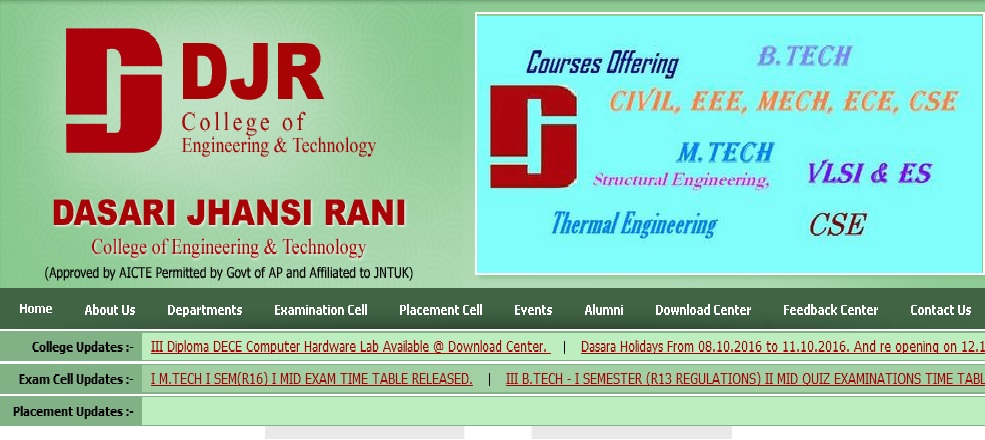RR10202 Radar Engineering B.Tech Question Paper : djriet.edu.in
Name of the College : Dasari Jhansi Rani Institute Of Engineering And Technology
University : JNTUK
Department : Electronics & Communication Engineering
Subject Code/Name : RR10202 – Radar Engineering
Year : 2008
Degree : B.Tech
Year/Sem : IV/II
Website : djriet.edu.in
Document Type : Model Question Paper
RADAR ENGINEERING Supple IV Year II Sem May 2008 : https://www.pdfquestion.in/uploads/djriet.edu.in/2998-RR420402-RADAR-ENGINEERING.pdf
RADAR ENGINEERING Regular IV Year II Sem April/May 2008 : https://www.pdfquestion.in/uploads/djriet.edu.in/2998_RR420402-RADAR-ENGINEERING.pdf
DJRIET Radar Engineering Model Question Paper
IV B.Tech II Semester Supplimentary Examinations, May 2008 :
RADAR ENGINEERING :
(Electronics & Communication Engineering)
Time: 3 hours
Max Marks: 80
Answer any FIVE Questions :
Related :Dasari Jhansi Rani Institute Of Engineering & Technology Information Technology & Numerical Methods B.Tech Question Paper : www.pdfquestion.in/2996.html
Set – I
All Questions carry equal marks :
1. (a) Obtain the Radar equation and discuss the various parameters which improve the performance of the Radar.
(b) Explain about applications of radar. [10+6]
2. (a) What is false alarm, and probability of detection.
(b) What is Radar Cross section? How does it control the performance of Radar? [8+8]
3. (a) Define Doppler frequency. Explain the significance of Doppler frequency while detecting the target.
(b) Derive an expression for the relative velocity of the target in CW Radar.
(c) Explain the limitations of CW radar. [6+5+5]

4. (a) Explain in detail the filter characteristics of the delay line canceler.
(b) Explain how the effect of blind speeds reduced by operating at more than one PRF. [8+8]
5. (a) Explain Tracking principles.
(b) Explain about sequential lobing. [8+8]
6. (a) What are the advantages of monopulse radar over conical scan radar.
(b) Explain the block diagram of amplitude comparison monopulse for extracting error signals in both elevation and azimuth. [6+10]
7. Write short notes on:
(a) Aperture illumination and efficiency of radar antennas.
(b) Loss in gain of cosecant squared antennas.
(c) Beam steering of phased arrays.
(d) P – Scope display. [4×4]
8. (a) Explain the characteristics of a cross-correlation receiver with a block diagram.
(b) Describe and differentiate between active ECM and passive ECM. [8+8]
Set – II
1. (a) Derive the Radar range equation.
(b) With a block diagram explain the operation of pulse radar. [6+10]
2. Discuss in detail the Radar Cross Section of targets and the Cross section fluctuations. [16]
3. (a) Explain the principle of Doppler effect and its application in CW Radar.
(b) Draw the block diagram of a simple CW Radar and explain its working. [8+8]
4. (a) Draw and explain frequency-response characteristics of an MTI using range gates and filters.
(b) What is the difference between MTI radar using range gates and an MTI with a single-delay-line canceler. [8+8]
5. (a) Differentiate the operation of pulse radar from simple cw radar.
(b) Draw the output waveforms from mixer for the different range of Doppler frequency.
(c) Draw the different sweeps of an MTI radar on A-scope display. [6+5+5]
6. (a) How is radar target acquired in a typical radar?
(b) What factors determine the range and angular accuracies in a radar? [8+8]
7. (a) Explain the significance and utility of radomes.
(b) Describe the structural features of a Cassegrainian antenna and bring out its merits. [8+8]
8. Write notes and explain about:
(a) Passive ECM
(b) Matched and non-matched filters
(c) North filter.
(d) Antijamming techniques. [4×4]
Set III
IV B.Tech II Semester Supplimentary Examinations, May 2008
Radar Engineering
(Electronics & Communication Engineering)
Time: 3 hours
Max Marks: 80
Answer any FIVE Questions
All Questions carry equal marks
1. (a) Describe the working principle of pulsed Radar system.
(b) Derive the range equation and discuss about its limitation. [8+8]
2. Explain the following:
(a) Prediction of range performance
(b) PRF and range ambiguities.
(c) Transmitter power. [5+6+5]
3. (a) What is the purpose of filter banks in CW Radar receivers. Draw the block diagram of IF Doppler filter bank and draw its frequency response .
(b) For a given Doppler filter bank ,can the velocity resolution be made smaller by increasing or decreasing the transmitted frequency? Explain your answer.[10+6]
4. (a) What is the difference between single cacellation and double cancellation in delay line cancelers? Explain.
(b) An MTI Radar system operating at 10GHz and a repetition rate of 1000Hz receives echoes from an aircraft that is approaching the radar with a radial velocity component of 1 km /sec. Determine the radial velocity component as measured by the radar. [8+8]
5. (a) Differentiate the operation of pulse radar from simple cw radar.
(b) Draw the output waveforms from mixer for the different range of Doppler frequency.
(c) Draw the different sweeps of an MTI radar on A-scope display. [6+5+5]
6. (a) Compare the tracking techniques.
(b) Explain in detail about limitations to tracking accuracy. [10+6]
7. Write short notes on:
(a) Aperture illumination and efficiency of radar antennas.
(b) Loss in gain of cosecant squared antennas.
(c) Beam steering of phased arrays.
(d) P – Scope display. [4×4]